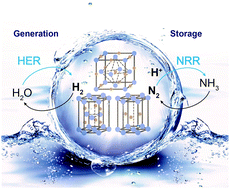当前位置:
X-MOL 学术
›
Mater. Horiz.
›
论文详情
Our official English website, www.x-mol.net, welcomes your
feedback! (Note: you will need to create a separate account there.)
Interface engineering in transition metal carbides for electrocatalytic hydrogen generation and nitrogen fixation
Materials Horizons ( IF 12.2 ) Pub Date : 2019-09-17 , DOI: 10.1039/c9mh01094g Min Kuang 1, 2, 3, 4 , Wenjing Huang 1, 2, 3, 4 , Chidanand Hegde 2, 3, 4, 5, 6 , Wei Fang 1, 2, 3, 4 , Xianyi Tan 1, 2, 3, 4 , Chuntai Liu 7, 8, 9, 10, 11 , Jianming Ma 7, 8, 9, 10, 11 , Qingyu Yan 1, 2, 3, 4
Materials Horizons ( IF 12.2 ) Pub Date : 2019-09-17 , DOI: 10.1039/c9mh01094g Min Kuang 1, 2, 3, 4 , Wenjing Huang 1, 2, 3, 4 , Chidanand Hegde 2, 3, 4, 5, 6 , Wei Fang 1, 2, 3, 4 , Xianyi Tan 1, 2, 3, 4 , Chuntai Liu 7, 8, 9, 10, 11 , Jianming Ma 7, 8, 9, 10, 11 , Qingyu Yan 1, 2, 3, 4
Affiliation

|
With an increasing energy consumption rate and rising global population, constructing sustainable energy technologies has become one of the major scientific challenges. Therefore, the development of electrocatalytic conversion technologies that can convert renewable resources, such as water and nitrogen, into value-added chemicals or fuels (e.g., hydrogen and ammonia) can be crucial. A number of transition metal carbides (TMCs) have been investigated over the past few years as effective electrocatalysts for various reactions. This is mainly owing to their unique electronic structures, which leads to high electrical conductivity and chemical stability. Moreover, the reactivity of TMC-based electrocatalysts is highly dependent on their surface and interfacial properties. This review focuses on tuning nanostructures and interfaces to enhance the electrocatalytic activity of TMC-based materials for hydrogen production and nitrogen fixation. The mechanisms behind the surface and interface engineering are discussed, including the synergy effects, facet binding energy, active defects, and low-coordinated sites. In particular, studies on activity enhancement through design of the interfacial phase, composition, and structure in TMC-based electrocatalysts are highlighted. The effective tuning strategies might pave the way for future development of highly active TMC-based electrocatalysts for sustainable energy-related conversion.
中文翻译:

过渡金属碳化物的界面工程用于电催化制氢和固氮
随着能源消耗率的提高和全球人口的增加,构建可持续能源技术已成为主要的科学挑战之一。因此,电催化转化技术的发展可以将水和氮等可再生资源转化为增值化学品或燃料(例如,氢和氨)可能至关重要。在过去几年中,已经研究了许多过渡金属碳化物(TMC)作为有效的各种反应电催化剂。这主要归因于其独特的电子结构,从而导致高电导率和化学稳定性。而且,基于TMC的电催化剂的反应性高度依赖于它们的表面和界面性质。这篇综述着重于调整纳米结构和界面,以增强TMC基材料用于产氢和固氮的电催化活性。讨论了表面和界面工程背后的机理,包括协同效应,刻面结合能,活性缺陷和低配位部位。特别是,着重研究通过设计基于TMC的电催化剂的界面相,组成和结构来增强活性。有效的调节策略可能为未来开发高活性TMC基电催化剂以实现可持续的能源相关转化铺平道路。
更新日期:2020-01-04
中文翻译:

过渡金属碳化物的界面工程用于电催化制氢和固氮
随着能源消耗率的提高和全球人口的增加,构建可持续能源技术已成为主要的科学挑战之一。因此,电催化转化技术的发展可以将水和氮等可再生资源转化为增值化学品或燃料(例如,氢和氨)可能至关重要。在过去几年中,已经研究了许多过渡金属碳化物(TMC)作为有效的各种反应电催化剂。这主要归因于其独特的电子结构,从而导致高电导率和化学稳定性。而且,基于TMC的电催化剂的反应性高度依赖于它们的表面和界面性质。这篇综述着重于调整纳米结构和界面,以增强TMC基材料用于产氢和固氮的电催化活性。讨论了表面和界面工程背后的机理,包括协同效应,刻面结合能,活性缺陷和低配位部位。特别是,着重研究通过设计基于TMC的电催化剂的界面相,组成和结构来增强活性。有效的调节策略可能为未来开发高活性TMC基电催化剂以实现可持续的能源相关转化铺平道路。











































 京公网安备 11010802027423号
京公网安备 11010802027423号